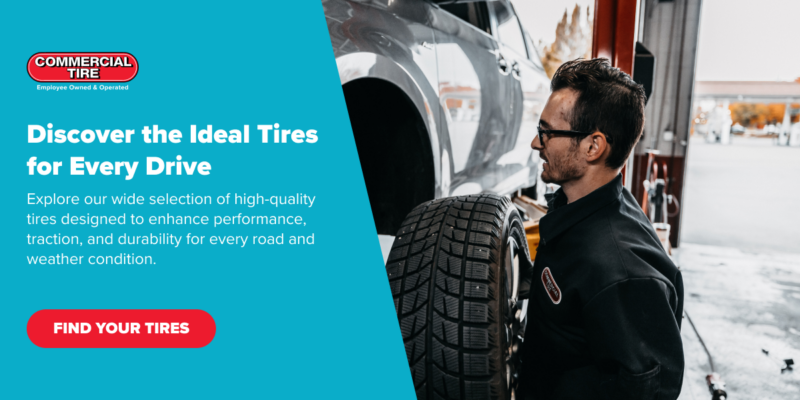When it comes to winter driving, choosing the right tire can mean the difference between a smooth, safe ride and a white-knuckle experience. Winter tires and all-season tires each have distinct advantages, but understanding which is best for you requires knowing how they perform in different weather conditions.
Let’s break down the differences and explore which option best suits your climate, driving habits, and vehicle needs.
If you’re looking for other tire types, Commercial Tire is your go-to. We offer all terrain tires, high performance tires, and highway tires, ensuring we have the right option for every driving style.
Understanding the Difference Between Winter and All Season Tires
At first glance, winter tires and all-season tires might look similar, but they’re built for very different tasks. All-season tires, true to their name, are designed to handle a variety of weather conditions year-round, from hot summer roads to mild winter days. Winter tires, however, are specialized for extreme winter conditions, such as icy roads, freezing temperatures, and heavy snowfall. They’re built with softer rubber compounds, unique tread patterns, and sometimes even studs, all engineered to grip icy, snowy surfaces more effectively.
Understanding these differences is key to making the right choice for your winter months ahead, especially if you frequently drive in freezing temperatures or packed snow. As a trusted provider of tire and wheel alignment services, Commercial Tire is here to help you decide what best suits your driving lifestyle.
Winter Tires: When and Why They Are Necessary
Winter tires are purpose-built for one thing: winter weather. These tires are made with a softer rubber compound that stays flexible even in sub-zero temperatures, providing much-needed traction on icy roads. Winter tires often come with deeper treads and a unique tread pattern designed to channel away slush and snow, which helps prevent snow buildup.
For drivers in regions that experience frequent snow and cold weather, like Idaho or Utah, winter tires are highly recommended. Their soft rubber, enhanced grooves, and sometimes studded treads are crafted for extreme winter conditions, including heavy snow, icy conditions, and temperatures below 45°F. These features not only improve traction but also help in braking more effectively on snow and ice.
When mounting winter tires, many drivers also consider seasonal tire rotations and ensuring the correct tire pressure for winter driving, as cold temperatures can impact tire performance.
All Season Tires: Versatility and Limitations
All-season tires, on the other hand, are designed to perform well across a range of weather conditions. They can effectively handle rain, mild snow, and dry pavement, making them an excellent choice for drivers in areas with mild winters. While all-season tires provide decent performance in a variety of conditions, they lack the specialized features of winter tires.
Unlike winter tires, which are made of a softer rubber compound, all-season tires are crafted with a medium rubber compound that performs well in both cold and warm weather without excessive wear. However, this balance means they’re less effective in harsh winter conditions. If you’re dealing with icy roads or packed snow regularly, all-season tires may not provide the level of control you need. But for areas with lighter snowfall and occasional freezing temperatures, all-season tires offer a convenient, cost-effective solution.
For those who need a solution that falls between the capabilities of all-season and winter tires, all-weather tires might be the answer. Unlike all-season tires, all-weather tires are designed to handle colder temperatures and provide better traction in snow and ice without the need for changing tires seasonally. For more details on all-season tires vs. all-weather tires, see our full article.
Performance Comparison: Winter Tires vs. All Season Tires
Now, let’s dive into the nitty-gritty of how winter tires stack up against all-season tires in specific performance areas. Here are the differences between snow tires vs. all season tires:
1. Traction in Snow and Ice
When it comes to gripping snow and ice, winter tires have a clear advantage. The softer rubber and deeper tread pattern are specifically designed for maximum traction on slippery surfaces. In snowy conditions, this means better control, more confident handling, and a reduced likelihood of skidding.
While capable of light snow, all-season tires just can’t match the traction winter tires provide on icy roads or during heavy snowfall. They’re built to tackle rain and moderate snow but may slip in extreme winter conditions where a snow tire would excel.
2. Wet and Dry Road Performance
On wet and dry roads, all-season tires generally outperform winter tires. Winter tires are built for cold temperatures, and their softer rubber compound can wear out faster in warmer conditions. All-season tires are engineered for varied conditions and tend to offer a smoother ride and better grip on wet roads. They channel water away effectively, reducing the risk of hydroplaning and providing reliable control in rainy weather.
3. Tread Life and Durability
In terms of tread life, all-season tires typically have the upper hand. Their medium-hard rubber compound is designed for longevity, which makes them an excellent year-round choice for drivers in mild climates. Winter tires, however, are meant for the cold months only. If used year-round, they’ll wear down quickly, making it essential to switch them out when the weather warms up.
Which Tire Should You Choose Based on Climate and Driving Habits?
If you are planning on buying new tires, you have to choose the right one. Picking a tire will depend on where you live and how you drive. Here’s a look at what each type offers for different climates and driving habits.
Cold-Weather Regions: Why Winter Tires Are Best
If you’re driving in areas that experience cold temperatures, heavy snowfall, or icy conditions, winter tires are the way to go. Regions with long, harsh winters, like the northern U.S. or mountain areas, benefit greatly from the additional traction and safety winter tires provide. They’re built to maintain flexibility in freezing temperatures, offering enhanced control, better braking distances, and peace of mind during the coldest months.
Switching to winter tires isn’t just about better grip, though. In many cold-weather areas, having winter tires is considered essential for safe winter driving, just as much as wheel alignment and wheel balancing are for ensuring even tire wear. By investing in a good set of winter tires, you’ll also reduce the wear on your summer tires or all-season tires, extending their life.
Mild Climates: When All Season Tires Are Enough
For those in mild winter regions, like the Pacific Northwest or southern U.S., all-season tires can offer year-round convenience without the need for seasonal changes. These tires perform well in rain, light snow, and dry conditions, making them a practical choice if you don’t face extreme winter conditions. Their tread design is versatile enough to handle a variety of weather conditions, making them a great option if you’re dealing with everything from occasional rain to light winter weather.
However, if your region sees only brief periods of freezing temperatures or the rare light snow, all-season tires will likely be enough to keep you safely on the road. Plus, with regular maintenance like tire rotations and alignment checks, your all-season tires can provide consistent performance year-round.
No matter what tire you choose, you should always consider looking for a trusted tire shop and tire repair services.

Shop for Winter and All Season Tires at Commercial Tire
Choosing the right tire for winter driving—or any season—is essential for your safety, and at Commercial Tire, we’re here to help you make an informed decision. Whether you’re looking for winter tires, all-season options, or even summer tires, our team is ready to guide you through the process of finding the best fit for your vehicle and driving needs.
If you’re looking for other tire types, Commercial Tire is your go-to. We offer all terrain tires, high performance tires, and highway tires, ensuring we have the right option for every driving style.
With Commercial Tire’s expertise, you’re investing in quality, safety, and long-lasting performance. We offer professional tire and wheel alignment services to ensure your new tires perform optimally and wear evenly. With our comprehensive services available across multiple locations, you’re always close to the tire support you need, whether it’s in Washington, Idaho, Utah, or Oregon. Find a tire shop location near you today!
